Despite my general fear of the tanking economy and growing reluctance to spend any money, I had to indulge my curiosity when I heard that David Cronenberg and Howard Shore, under commission from the LA Opera were adapting their own work, THE FLY. I am not an opera buff, but I have been known to use the adjective "operatic" to describe things melodramatic or grand in scale. Although it seemed an unlikely choice for high-brow theater, the story does have operatic qualities. It's Frankenstein, or the Phantom, or some other tragic monster who probably has precedent on the classical stage.
Without knowing the stories, there are opera selections I've listened to that drew me in through musical storytelling. In the same way that I laughed the first time I heard Frank Zappa's Peaches en Regalia, I've come to appreciate classical music that can paint pictures in your brain. Once enthralled by the music, I may be interested enough to seek out the story ( which often sounds like an illustration of the music, like the best jazz vocals can capture the musical storytelling in lyric ).
I belong squarely to the "outsider" demographic that LA Opera director Placido Domingo is appealing to with his recent recruitment of film directors. Many of the opera or symphonic selections I am aware of made their way into my consciousness because I heard them in films. A number of venerated filmmakers have turned to classical for their scores, eschewing any genre of contemporary composition. Kubrick's view was that he could never get a contemporary film composer to top what a Strauss or Stravinsky had done. Can't exactly disagree with that one.
Howard Shore is, I guess, one of the more respected contemporary film composers. His Lord of the Rings score is distinctive and effective, although I felt it was slightly overused in the edit. Like anyone else in Hollywood, he's done his share of "work-for-hire"; stuff that probably meant no more than a paycheck to him. But he's worked pretty consistently with David Cronenberg, which would suggest that the collaboration is based on more than paying the mortgage.
Shore started out scoring with Cronenberg back when Cronenberg was known as more of a horror genre filmmaker. Cronenberg, with The Brood, Scanners and Videodrome, had not quite defined his own high-brow art-house, existentialist-horror genre yet, but he was on the way. Shore was there when Cronenberg first adapted The Fly, a 1950s creature-feature, into a mid-80s horror masterpiece of brain vs body.
Apparently, it was Shore's thinking years ago that THE FLY would be a great subject for opera, so once he got the commission and composed the piece, it was around him that the other creative personnel for this production coalesced. Unfortunately, if you are going to tell a story through music - a story that many are already familiar with because you have already told it - the music should be strong enough to justify it's own existence. That's not the case for THE FLY opera.
Nothing about the score was "operatic" in the sense that I would use the word. Nothing grand, or powerful and dark, like Wagner, like I might expect for a story about a man turning into an insect. Nothing much at all. Most of the score sounds like an indistinguishable sound bed of white noise - call it buzzing if you want to be charitable. It's a flat background color for the voices - which are equally written flat. Nothing ever manages to punch through and create an emotion. I found myself distracted by the English dialogue. Perhaps since operas are usually in Italian or German, when I've heard them in the past I have not been focused on the weakness of the dialogue. Here, it was inescapable, and there was the presence of the electronic libretto display above the stage ( which I suppose is now common to all opera performances ) to draw further attention to how laughably awful the sung lines were: "Care for a smoke? -No thank you, gave it up." That's by no means the worst of it, just an example of the banality.
The show was so bad, at times I found myself closing my eyes to see if the experience worked better for me as music alone - it did not. I read that Cronenberg wanted this to be different from his film, but with so much of it following the film exactly - even dialogue chunks lifted wholesale - I wondered what kind of "different" he could have possibly been going for. The film is creepy, scary, repulsive. It might exist in a genre ghetto ( you will probably never see ladies in gowns going the Chandler to see the film ), but it succeeds in its goals - it repulses you. And it does that with score, make-up, lights - the same basic ingredients available to the opera. So why does opera occupy some higher space in the cultural hierarchy? If anything, this production proves that opera can be as flaccid as television.
In the film, Jeff Goldblum contorts his body and literally transforms himself into the Brundlefly. The actor playing Brundle on stage was gifted with some impressive physical abilities, performing several feats of gymnastic strength to hammer home the point of his transformation, but he couldn't top Goldblum's total devolution, which was aided in part by outstanding special-effects make-up. Hell, Goldblum looked a little like a fly BEFORE he put the make-up on, which in a way, might've been part of the point. Isn't it about the internal being externalized? This production works overtime to try to make the connection between physical transformation and metaphysical meditation. Believe it or not, the film with all of its slime and gore, comes off more subtly in this regard because it lacks the blunt attempts to make the audience see the "existentialism" of the piece. The great thing about cheap sci-fi and horror is that, at its best, it's anything but cheap. There are great ideas and symbols lurking in it - it never tries to "legitimize" itself with blatant intellectual soap-boxing - it's messages are often deliberately encoded.
Up in the cheap nosebleed seats I saw a few people who belonged to my demographic: many of us know that we should dress up to go to opera, but have no idea how to properly do it ( purple shirts and red ties and black leather jackets and ponytails ). Even with Cronenberg-love in the house, people could not help themselves from giggling at the lame dialogue, the puppet monkey in Brundle's telepod, or Brundle's "full monty" moment. If you are a fan of the film, just recall the incredulity you felt on hearing that this would be an opera, and then the acceptance that it could be really cool. Then imagine a dark empty stage and a chorus of singers performing as the voice of Brundle's computer, narrating about 10 minutes worth of narrative events from the film, and let your feelings of disbelief return. When Brundlefly visits a poolhall and rips the arm off of a local tough guy, a scene which is inflated from a movie gross-out shock to a full blown song where the victim closes the scene alone in a spotlight, I was reminded of the cast of the Simpsons staging their production of Tennessee Williams' Oh Streetcar! Someone next to me mumbled that he was waiting for the Sharks and the Jets to make their appearance.
What sucks about watching something bad is knowing all the work and talent that went into it. Although Shore gave the singers little to do, there were times when they delivered appreciable power from the vocal cords - it just wasn't harnessed into anything that made you feel. For a story about a cerebral guy who wants to free himself from "the flesh," the opera seemed to have liberated itself rather effectively from the emotions. I felt bad that people were up there working hard but failing to connect. They were like foot-soldiers being marched into cannon fire, brave but doomed.
Afterwards, we went to get a drink and I spotted someone I thought I knew at the entrance to the restaurant. I realized later that it was Howard Shore. I thought again about wartime defeats, only this time from the point of view of the generals who had to drink themselves to sleep after sending their men to their deaths. With bad reviews coming in from the Paris debut and now Los Angeles too, I hope the bartender mixed him a strong one.
Monday, September 15, 2008
Metamorphosing into a Shapeless Mess: The Fly The Opera
Saturday, August 09, 2008
Charles Brown Driftin'
Just wanted to share some music from one of the greatest blues singers I've ever heard.
I heard this guy's voice on the radio when I was about 17 and I never forgot the song. I tried singing it for people in the record store - even at places like Amoeba, for their Jazz and Blues "specialists," and no one could place it. (I acknowledge my rendition could have been a bit lacking, but still... )
I finally found out the song I had heard about 14 years ago was Through the Courtesy of Love, by Charles Brown.
As it turns out, he was nowhere near as obscure as I would have thought, based on the trouble it took to track down the CD.
He's in the goddamn Rock n Roll Hall of Fame!
I've got a James Brown Christmas album with a Charles Brown cover on it - and I never knew it! (To be fair, it's one that James croons his way rather well through, but now having heard the original, it sounds like a Charles Brown impersonation).
Interestingly, he passed away in my hometown of Oakland just a few years ago.
Apparently he had a resurgence of popularity in the 1990s and did some touring. This would have been right around the time I heard him on the radio (which makes an awful lot of sense in retrospect). What a bummer I never figured out who he was until after he died.
At least the life of the art is extending on.
Check out this video of him performing his signature hit "Driftin'" in Los Angeles in the 1980s.
Sunday, June 22, 2008
Toyama Medicine

This origami cube advertises "Toyama's Medicine - 300 Years of History."
I usually don't indulge in travel souvenirs.
I take photos, but don't really need trinkets. And I am bad at finding those for other people. They always strike me as kind of chintzy. But while I was in Japan this year, I stopped at Iwase, a port town in Toyama prefecture, and found a small trinket shop with a medicine counter. As it turns out, Toyama is famous for its medicines, having a long history of powders and treatments being brought to rural customers by itinerant druggists.


A traveling drug salesman from olden times, and one from more recent times.
I fell in love with the package design of these slim envelopes, and Tomoko suggested I buy some - as a souvenir. I couldn't resist, and once committed to the idea, could not limit myself to only a few. So I picked up about $50 worth of medicines that I will never use - headache powders, stomach relief, and what all else I don't even know. But the art on these is so nice I wanted to put them up here for people to see.






They remind me a little bit of Polish movie posters - which I have written about on this blog before. This is product design without the boring constrictions so typical in the US. I know a lot of people don't think much about advertising, but I work in that industry, and trust me, the people who make it often think too much about it. Which is part of the reason why I think it tends to look so uniform and uninteresting. Avoiding photography and choosing instead to go with an entirely hand-painted approach automatically contributes more life to these designs. But I also love their color palettes, text treatments, and the depictions of masks, demons and devils.






After displaying these packets proudly to Tomoko's mother, she told me that the tradition of traveling drug salesmen continues to this day in Toyama. She pulled a plastic pill box down from atop her refrigerator and showed several packages of her own. She explained that the box was left stocked in each home, and when the salesman returned he deducted what was used from the box and presented a bill for it. In some of the rural areas of Gifu, south of her house, I could definitely see this kind of service being useful, but in the suburbs of Toyama it was mostly just an interesting holdover from an earlier time.
I might have looked a little strange in the drug shop, a foreigner with a camera around my neck, ogling the merchandise, but I was probably the biggest customer for headache powders all that week.

The Heat is Back
Two months since last post. I don't know how many years since last confession.
Summer officially began yesterday - June 21. With it came the heat. The heat may have arrived a little earlier actually, but I have been putting in long shifts in an air-conditioned building all week, so I wouldn't really know the difference.
It was 97 yesterday. Feels about the same today.
Here's to hoping the power doesn't blow, as it did 5 consecutive days last year. ( I think DWP finally upgraded all the equipment for this street ).
In other news - my old domain is gone. This blog is now hosted on blogspot.com
rivas-splicer.com is property of ICDsoft until 2009 - bastards. If you register a domain through them, you are actually subletting. They own it for another year after you let it go. Makes it harder to switch services. Still, since all of my content is now being hosted on free servers (the future - no, the present state - of non-commercial internet use), I could not justify paying $60/year for hosting anymore.
In other other news - all my old video editing equipment has been sold off (finally) and the money has promptly disappeared into the newest hobby - photography. Picked up a used Canon 30D before the Japan trip in April (pictures of which are uploaded here and here). Just picked up two 580EX II flash units. Ny next goal is to learn studio lighting with the flash units - and also start using them outdoors - kinda the way trained commercial photographers do. Flickr has been an inspiration. You can learn a lot by seeing so much great work for free in one place. Now let's see if I can actually learn it-learn it... opening your eyes to something is one thing. Applying it is another.
Got a bootlegged copy of an old British Hammer studios horror film called Maniac, or The Maniac. (Not to be confused with the 1980s film with Joe Spinell). A blow-torch killer movie. Yow. Kerwin Matthews from Sinbad.
Returned to reading Gore Vidal's Lincoln. Gave it up in 2006 because of stuff interrupting my life. Now I'm fascinated with Civil War era history. Lincoln was reviled by many when he took office. Assassination was threatened before he was sworn in. He imprisoned rebels without trial. He took 2 million from the Treasury for the war without approval from Congress. He confiscated communications from telegraph offices in an attempt to intercept rebel transmissions, not unlike the current NSA wiretapping program. There was no income tax prior to the Civil War. There was no currency issued by the US government - there were many currencies issued by over 3000 independent banks, making counterfeiting a rampant problem.
I am hungry for waffles. I need to brave the heat and take a subway ride to Hollywood and Vine to get some waffles and visit the bookstore.
People are bitching about gas prices. It's currently about $4.70/gallon. Never thought we'd see it. In 2000, I was buying gas in Van Nuys for $0.96/gallon. They tell us we've always had it easy in the US. People want their freedom to drive. So we don't use public transport and don't conserve. This is the "freedom" we are fighting for.
PS - domestic drilling, hydrogen, biofuels, and hybrids are paying lip service to rising prices and global temperatures.
Hybrids get the same MPG as economy cars from 10 years ago. Hydrogen requires enormous energy to produce. Biofuels can wreak havoc on agriculture. Drilling and exploration destroy the environment.
People should realize that fully electric cars already provide the speed and range they require. Most people do not travel over 100 miles per day. If we embrace them, they'll get better and cheaper. And we can start producing more of our electricity from renewable sources. Why are we putzing around? Someone needs to start kicking asses on this.
End of rant.
Monday, April 14, 2008
La Smog di Rossi
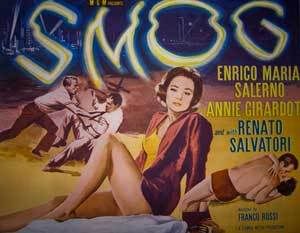 Smog is an Italian film directed by Franco Rossi from 1962. It screened April 7 at the Billy Wilder Theater (within the Armand Hammer museum) in Westwood, which seems to be the new home of the UCLA Film Archive. I went to see it because I learned that it was shot in LA, and I've become one of those Angelenos who loves to do cinematic archaeology of the city. Smog is also one of those films which does not exist on DVD in any form at the moment (bootleg or otherwise), and I really make an effort to see those kinds of rarities when I can.
Smog is an Italian film directed by Franco Rossi from 1962. It screened April 7 at the Billy Wilder Theater (within the Armand Hammer museum) in Westwood, which seems to be the new home of the UCLA Film Archive. I went to see it because I learned that it was shot in LA, and I've become one of those Angelenos who loves to do cinematic archaeology of the city. Smog is also one of those films which does not exist on DVD in any form at the moment (bootleg or otherwise), and I really make an effort to see those kinds of rarities when I can.
The title "Smog" grabbed me, leaving me wondering if there was any connection to Italo Calvino's short story, "La nuvola di Smog." I read the story several years ago and tossed around ideas for adapting it into a short film as I drove my commute in-and-out of Hollywood on La Cienega everyday, past oil drills pumping in the shadows of Baldwin Hills suburban ranch homes. The film had no connection to Calvino, but I was happy to find a nice little cinematic gem. This film shows some interesting locations, from the opening at LAX to Sunset and Hollywood Boulevards, to the oil fields in (what is referred to as) Culver City. ( They looked a lot like the ones off La Cienega, but it was hard to be sure ). It's interesting to see what's changed and what has stayed the same. Beyond just the physical locations, it's interesting to see the portrayal of an ex-pat community in Los Angeles, since communities of foreign-born people, like the landmarks, are characteristic of the city. In 2008, I have not encountered any large community of Italian-born people in LA, and I wondered whether this reflected a reality in 1962 that has since changed. But the attitudes and ideas could be transposed to Korean or Latin-American or what-have-you.
The story is simple: A lawyer from Italy has a stopover in LA on his way to handle a case in Mexico. He is released from the airport without passing through immigration by an airline attendant who keeps his ID. He intends to do some brief sightseeing in Hollywood, but quickly discovers that the real Hollywood is nothing like what he imagined. Unable to function in English, he quickly falls in with various Italian ex-pats, making friends with their affluent and well-connected American contacts. Most of the Italian people Vittorio comes in contact with are hustling different jobs, installing stereo equipment, teaching Italian language to rich housewives, doing caricature artwork, etc. One of them, Mario, is a particularly ambitious Jack-of-all-trades type who sinks below Vittorio's standard of morality with his credo of "A little ingenuity, a lot of nerve." 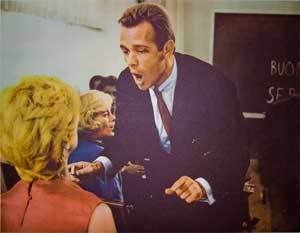
Renato Salvatori as Mario, teaching Italian to idle housewives.
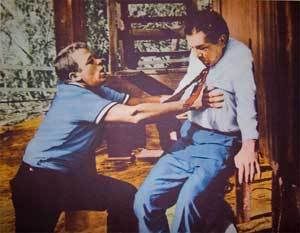
Mario and Vittorio (Enrico Maria Salerno) later have out over some cash missing from Vittorio's jacket pocket.
Vittorio sees himself in a different class of people than most of the countrymen he meets in Los Angeles. When asked by an airline attendant if he would like to pass time in a waiting room with an Italian couple he'd met on the plane, Vittorio shrugs them off, saying, "They're just some immigrants I met on the plane. Italians are OK in Italy, but..." He seems to find much more in common with the affluent people he meets at a Pasadena cocktail party, even if they mispronouce his name, insist that he is the "ambassador of somewhere," or generally rely on him for entertainment.
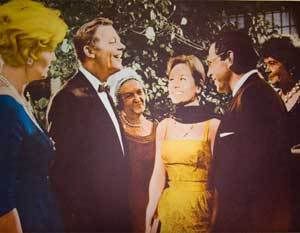
Vittorio accompanies Gabriela to a high-society cocktail party, where he seems to feel right at home, despite his inability to be understood.
I read the film as a statement on the difficulty of connecting on an honest human level with anyone in the city, regardless of their language or nationality. It's a familiar theme in many movies about Los Angeles, and is explored visually through Vittorio's outsider perspective. At times, the "smog" layer which inhibits human contact is so thick (as in a bowling alley's barroom, choked with cigarette smoke) that it is nearly impossible to see the faces in front of you. Race, class and language are the obvious barriers dividing people, but even Mario and Gabriela, who share a language, culture and situation as foreigners, seem to be pursuing dreams on parallel but separate paths, only overlapping when they need each others' comfort. In this regard, although Smog may have originally been made primarily for an Italian audience (not sure about this, but it is mostly English-subtitled Italian language), it belongs solidly among the ranks of other films about LA, many of which observe the isolation of its people.
 ** I did a search for information about the film on the internet and found a review that Time magazine published in 1962. It leads me to believe there may be two endings to this film, since the one mentioned in the review differs from what I saw. The Time review mentions Vittorio becoming trapped in the home of an architect, where design has overwhelmed function. The ending I saw had a considerably less sardonic tone, leaving Vittorio to revel at the party with his new friends, and following Gabriela back to the home she dreams of buying. Gabriela, the passed-over girl who leaves the party alone, spends the night with Mario, the uninvited, who nonetheless understands status even if he cannot transcend his own. Although they have each other, it is only for the night, and the film ends with Gabriela watching Mario drive away to begin his hustle anew. If this film ever sees the light of day on DVD, it would be cool to find out whether or not there was an alternate ending, and why.
** I did a search for information about the film on the internet and found a review that Time magazine published in 1962. It leads me to believe there may be two endings to this film, since the one mentioned in the review differs from what I saw. The Time review mentions Vittorio becoming trapped in the home of an architect, where design has overwhelmed function. The ending I saw had a considerably less sardonic tone, leaving Vittorio to revel at the party with his new friends, and following Gabriela back to the home she dreams of buying. Gabriela, the passed-over girl who leaves the party alone, spends the night with Mario, the uninvited, who nonetheless understands status even if he cannot transcend his own. Although they have each other, it is only for the night, and the film ends with Gabriela watching Mario drive away to begin his hustle anew. If this film ever sees the light of day on DVD, it would be cool to find out whether or not there was an alternate ending, and why.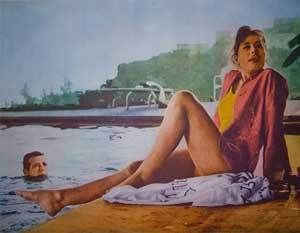
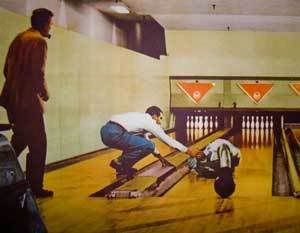
Mario takes a dip in Gabriela's dream pool. Vittorio passes out after drinking too much at the bowling alley.
Friday, March 07, 2008
Restaurant Revenge
 Every now and again, when I have to stay late at work, I end up putting my name down on the "dinner order" list. It's a service the company provides when you stay past the normal 8 hours, so you can keep working without leaving your desk in search of food. Unfortunately, more often than not, the food we end up ordering ends up being disagreeable in one way or another.
Every now and again, when I have to stay late at work, I end up putting my name down on the "dinner order" list. It's a service the company provides when you stay past the normal 8 hours, so you can keep working without leaving your desk in search of food. Unfortunately, more often than not, the food we end up ordering ends up being disagreeable in one way or another.
I've been known by some to be a picky-eater. On the other hand, I've eaten stuff that might make a lot of other people puke at the mere thought of: I'm talking about bowls of guts served up hot and steamy from street vendors in Bangkok at 3 in the morning. I can and will put all manner of stuff down the hatch in the name of "experience," but when it comes to defining what kind of meal "hits the spot," or at least, "fills the void," I get a lot more discerning.
Most of the time, I turn my nose up at the "dinner order" list merely because I cannot stomach eating from the same place yet again. The pick-up is handled by our in-house driver/delivery team and the dispatch lady who works the night-shift does not like to have her drivers travel further than about 3 blocks. That puts severe limitations on dinner.
Anyway, since I've tried slipping other suggestions in, to no avail, the best revenge I could come up with, finally, to vent some of the ill-will that comes with being hungry and forced to settle for something dissatisfying (when more satisfying stuff beckons from home, less than 10 miles away), is to write a restaurant review and post it online!
This one is for Zeke's BBQ, and it's online at citysearch.com
To be fair, I contacted Zeke's management first, to complain about the burnt and oily food, but never received a response of any kind. I figured if they could torch my veggies, I could torch their rep. Honestly though, I can't imagine anyone being swayed for or against a place like Zeke's by a restaurant review.
BURNT VEGGIES TASTE LIKE CHARCOAL
03/06/2008 Posted by flyingdutchman
Another place that is conveniently located near my work. Unfortunately, like most of the other eateries around the Highland-Santa Monica-La Brea intersections, the food is not so hot. The one thing I can wholeheartedly recommend is the root beer. It's delicious. But then, Zeke's doesn't make it, they just sell it. The BBQ is so-so. I would go with a pulled pork, or brisket. I'm not a huge ribs guy. Food's not bad. But never eat their "grilled" veggies. Those BBQ'ers in the back like to torch the life out of the food, until it all tastes like ash. Is this some kind of macho revenge against vegetables? Does it make the BBQ more "authentic" if you incinerate the food? I've complained about it before and gotten no response. I give up. If I am forced to go there these days, because of work, I just eat the brisket, down a root beer and get on with life. Functional, but not enjoyable.
Pros: Great Root Beer in a big bottle
Cons: Most menu items are cremated
Wednesday, February 27, 2008
Bizarre New World: My Debut as a Comic Book Character
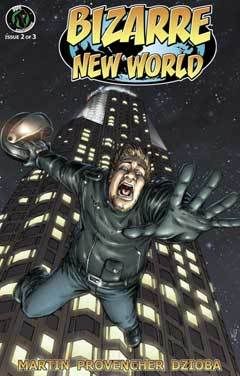 My friend Skipper Martin had been talking about this story idea of his for almost as long as I'd known him. The first time I heard it, it was not quite developed; mostly just a concept. I remember him giving me the intro over some Mexican food, and it went something along the lines of ... "Let me pick your brain for a minute... Suppose you could fly..."
My friend Skipper Martin had been talking about this story idea of his for almost as long as I'd known him. The first time I heard it, it was not quite developed; mostly just a concept. I remember him giving me the intro over some Mexican food, and it went something along the lines of ... "Let me pick your brain for a minute... Suppose you could fly..."
Skip, lover of all things Superman, wanted to write a story about a flying guy. A flying guy who resembled Skip. Uh-huh. Actually, even in that earliest incarnation, or swirl of ideas, Skip was imagining a flying world, because directly after the "what if you could fly" questions came the "what if everyone could fly" query.
I admit I was a little more focused on my margarita than on the idea of a story about flying people. It seemed too "Superman" to me. So Skip went away with the idea and came back a couple years later with a much more evolved pitch. He sent me a story outline with a three-act structure that had a strong father-son relationship, a villain, and a satiric take on religion and the media. In other words, something (other than the enchilada I had been eating last time) that I could really sink my teeth into.
One thing about Skip, the man has deep convictions. He believes in his own ideas - although not in an arrogant or immodest way. He is always open to other peoples' views. He always weighs his friends' opinions. But he has the kind of conviction that's necessary to do creative work, to take a project from his head to the sketchpad to completion.
Along with the story outline, Skip told me his plans to turn this into a serialized comic book. He was going to find an artist. He went out and shot "research photos" from a helicopter, to provide the artist with realistic aerial views. And every so often, I would get a peek at how things were progessing.
A half year or so later, Skip again prefaced one of our conversations with "Let me pick your brain..." He said he'd been mulling over the "problem" of how to explain his protagonist's ability. He wanted my theories on the subject. He said he wasn't convinced that it was actually important to his story, and I agreed. But he said he might want to do a scene where several characters discuss theories of how unaided human flight MIGHT be possible. I gave him my best theory, which came from my experience scuba diving. In short, I guessed that you could metabolize atmospheric gas into something lighter than air, which would be stored in your tissues, giving your whole body "buoyancy." Skip liked it.
When I received the first page layout showing myself in comic book form, I was amused to find that I was wearing the same London Underground T-shirt and grey hoodie. I guess some caricatures have some truth to them.So, several months later, I got a call from Skip saying he'd like to drop by my office to take a couple of "research photos" of me to give to his artist. He cruised by, jumped out of his car, snapped two or three quick shots and disappeared again.
All this while, Skip was busy working away on his book, unsure of how he would eventually get it out into the world. Everything was being done out of his own pocket. (Remember what I said about the strength of his convictions). He prepared a fine leather portfolio with oversize inked and colored pages to display to potential publishers. On the strength of that presentation, he was given meetings to discuss his book, and eventually got a distribution deal with Ape Entertainment.
The three-acts have been broken up into three "series" for publication, each consisting of three comic book issues. The first series, in which I make my cameo, was published to strong critical response last year. The next series, titled "Population Explosion," is due to hit stands soon.
Lately Skip has been a busy guy, doing interviews and promoting the book. I wonder if my character will ever return - with the ability to fly?
Pick up Bizarre New World at a local comic book store, or visit the website for more info.
You can hear Skip in an interview from cindy.com here.
JLPTの3級を受かった

Well, once again I passed the JLPT - Japanese Language Proficiency Test. The test is given every year around November or December and it takes until February to receive the results. There are four test-levels; level 4 and 3, which I have now passed, are the easiest. I understand that Level 2 is significantly harder. There are three sections to the test: Writing/Vocabulary, Listening, and Reading/Grammar. The only section I improved on from last year was Reading/Grammar. My listening really went down. I guess that's what happens when you stop taking classes.
Passing score was 240/400. I managed a 317 this time. 50 points down from last year. Guess I better study up if I plan to keep going.
Tuesday, February 05, 2008
The Endangered Iriomote Wildcat
I just read this article in the New York Times about the danger to the Iriomote Yamaneko and decided I'd like to add a few personal notes to it.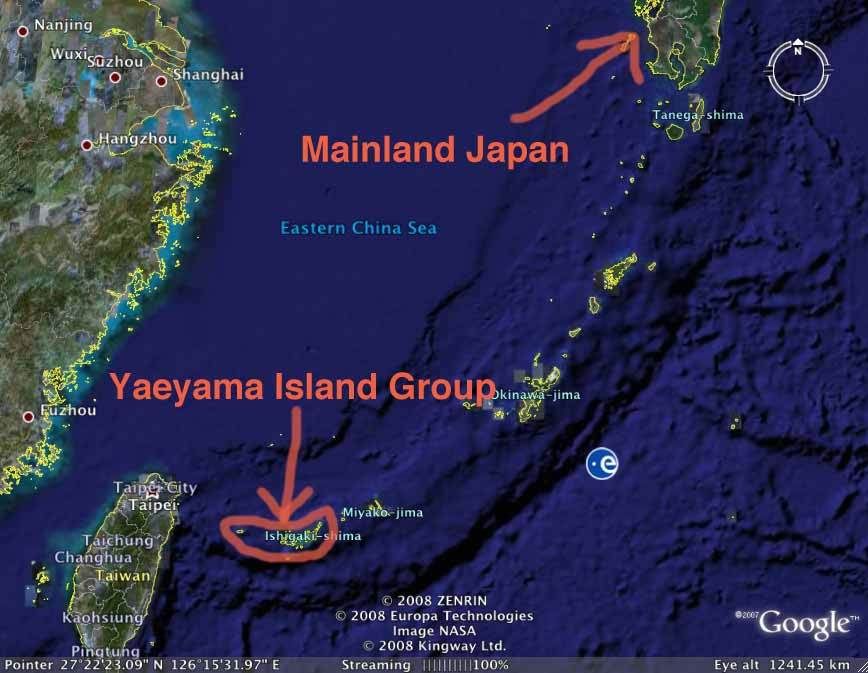 Last April I traveled to the Yaeyama Islands in Okinawa, Japan. It's a small island chain between the Pacific and the East China Sea, just shouting distance from Taiwan. It's a small sub-chain, along with the Miyako, the Kerama, and the main island of Okinawa (mostly known here as the home of the US military) that make up the prefecture of Okinawa. But the Yaeyama chain has it's own distinct flavor and culture, stemming from the small size of the islands and their mostly untouched rural nature. Most of the land is used for farming and raising cattle. The other main industry is tourism, with most tourists coming form within Japan. The landscape is so different from mainland Japan, that people want to come to experience something foreign and to relax in these undeveloped island settings. Kind of like US tourists going to Hawaii, but in the Yaeyamas, there is really nothing equivalent to the sprawl of Waikiki, which makes me feel like I am in downtown Santa Monica, CA. Ishigaki is the Yaeyamas' most populous island, and most of its population (about 44,000) lives in the capital city at the south of the island, preserving an undeveloped island feel for miles northward.
Last April I traveled to the Yaeyama Islands in Okinawa, Japan. It's a small island chain between the Pacific and the East China Sea, just shouting distance from Taiwan. It's a small sub-chain, along with the Miyako, the Kerama, and the main island of Okinawa (mostly known here as the home of the US military) that make up the prefecture of Okinawa. But the Yaeyama chain has it's own distinct flavor and culture, stemming from the small size of the islands and their mostly untouched rural nature. Most of the land is used for farming and raising cattle. The other main industry is tourism, with most tourists coming form within Japan. The landscape is so different from mainland Japan, that people want to come to experience something foreign and to relax in these undeveloped island settings. Kind of like US tourists going to Hawaii, but in the Yaeyamas, there is really nothing equivalent to the sprawl of Waikiki, which makes me feel like I am in downtown Santa Monica, CA. Ishigaki is the Yaeyamas' most populous island, and most of its population (about 44,000) lives in the capital city at the south of the island, preserving an undeveloped island feel for miles northward.
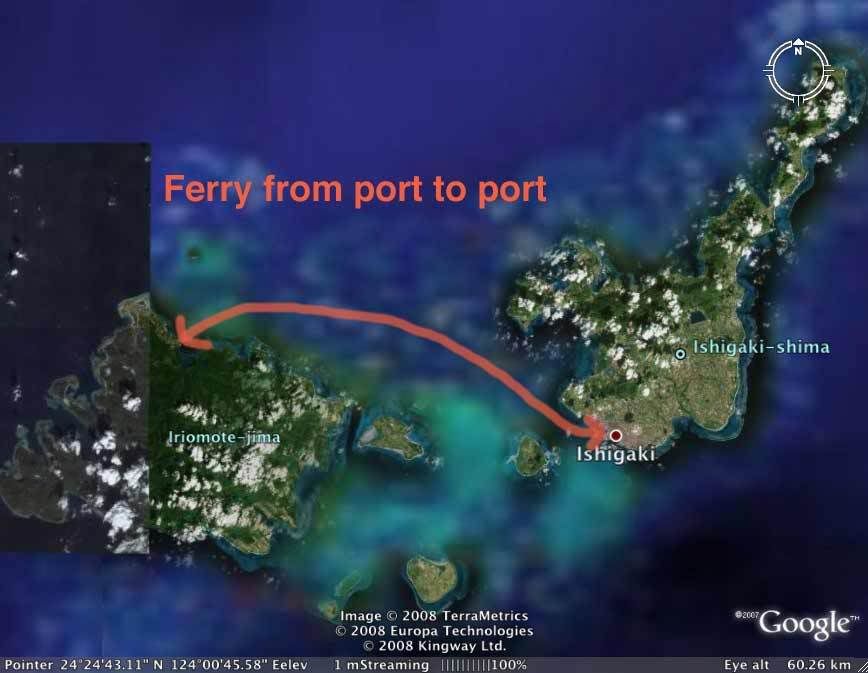

Among the chain is Iriomote island, about an hour by ferry from Ishigaki, which is the main travel hub in and out of Yaeyama. Iriomote is actually the largest island in the chain, but also the least populous (currently). With only 2,325 people, the island is designated as a national park by the Japanese government. From what I could see, tourism was indeed its biggest industry. Most of the island is an undeveloped natural paradise. There is one two-lane road that makes an arc around the western half of the island (the eastern half cannot be traveled by car). Most of the businesses (shops, inns, gas station), towns, beaches and other attractions are accessed by this road.  One of the biggest draws for me to visit there was the possibility of hiking into the unspoiled back-country. I read about this on a site written in limited English, and I just had to do it. So, with help from a Japanese-speaking friend, I contacted a guide who agreed to take me on the hike, which traverses the entire island in a day (approx 16km - not very hard, but all of it through wild jungle).
One of the biggest draws for me to visit there was the possibility of hiking into the unspoiled back-country. I read about this on a site written in limited English, and I just had to do it. So, with help from a Japanese-speaking friend, I contacted a guide who agreed to take me on the hike, which traverses the entire island in a day (approx 16km - not very hard, but all of it through wild jungle).
I read some accounts of English-speaking tourists doing the hike by themselves. There were a handful of American or British English language school teachers living in Japan, who traveled to Iriomote on their vacations and decided to do the hike. They gave good information, but also confessed that it was impossible at times to find the trail and it took them far longer to finish than was estimated. One very helpful blogger, Justin, corresponded with me and sent his photos taken with his girlfriend while on the hike. They could not read Japanese, though, and halfway through the hike they encountered a sign with writing in green and red. They followed the green arrow. They got lost, it began to rain and they had to pitch a tent. The next day, his girlfriend fell in a river and got her passport wet. They made it out and enjoyed it. I was not discouraged, but I did not want to spend the night in the jungle with the Habu - a poisonous, and nocturnal, pit viper.
As it turned out, enlisting the aid of the guide was one of the highlights of my trip. His name was Morimoto-san (nicknamed "Taishi"). Despite his limited English and my limited Japanese, he was a wealth of information about the jungle, having lived on Iriomote for years. He was not a native of the island, having moved there from Kyushu, but he was the only dedicated volunteer park ranger, and generally seemed to be regarded locally as a leading authority on the flora and fauna there. 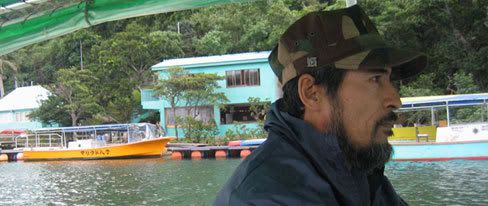
We drove together to the mouth of the Urauchigawa and boarded a boat upriver to the trailhead. While we hiked, he would identify trees, plants, bugs, even historical artifacts from the Ryukyu era and the coal-mining days, sometimes pointing to illustrations in a nature encyclopedia that he had contributed to. When our crossing was blocked by a fallen tree, Morimoto-san would pull out a fold-up saw he kept in his pack and cut through the branches. When we passed calf-deep through running water (acquiring some leeches in the process), there were ropes to hold onto, which Morimoto-san had tied in place previously.  If he saw the smallest scrap of an object foreign to the wilderness, like an old sock, he picked it up. Thankfully, there was very little of that kind of thing, since few people pass through here. He told me that he was not paid for serving as a ranger for the island, so acting as a guide provided him with an income while enabling him to maintain the wilderness.
If he saw the smallest scrap of an object foreign to the wilderness, like an old sock, he picked it up. Thankfully, there was very little of that kind of thing, since few people pass through here. He told me that he was not paid for serving as a ranger for the island, so acting as a guide provided him with an income while enabling him to maintain the wilderness.
When we reached about the halfway point, we passed the sign that had scuttled Justin and his girlfriend. Next to the green arrow Morimoto-san had written, "Dame," meaning "No good, don't pass this way." That path had been made impassable by a typhoon. The red arrow pointed the proper way out to Ootomi village, and after taking a short break we followed it. Again, I was glad I had chosen to go with Morimoto-san.
Iriomote is the world's only home to the yamaneko, which Morimoto-san told me was about the size of a housecat. This animal has been made famous in Japanese animation (thereby introducing it to an audience worldwide), but few people have actually seen the animal. Morimoto-san has seen it and a big part of his passion for preserving Iriomote's ecology is tied up with preserving the yamaneko. He told me that there were thought to be only about 100 of the animals left, and that each year an average of two were killed while crossing the island's only road. The road now has warning signs with images of the cat, drawn by Morimoto-san himself. 
After finishing the hike, Morimoto-san's wife picked us up at the south end of the island and we made our way back by car. Along the way, they pointed out two new hotels being built. Just last year, most of the lodgings on Iriomote were rather basic. The place I stayed was a minshuku - akin to a hostel, with simple rooms and tatami mat beds. The new buildings looked as if they might cater to a more deluxe class of traveler. On the one hand, this may be good for Iriomote's economy, and probably bring more business to Morimoto-san and other tour guides (not to mention more money for natural preservation projects), but their construction and existence also threatens the already perilous balance of nature on the island. The worst thing for Iriomote would be a large influx of tourists not interested in the jungle, but only in expanding the frontier of the "Club Med" type experience.
I did not see the yamaneko while doing the hike. But I hope that I could still have a chance to see one on a return trip.
If you decide to go to Iriomote, visit the jungle with Banana-House (Japanese only), Morimoto-san's tour company. You do not have to trek the entire island, he also offers kayak trips and other activities.
Also, look up Kanpira-So as a place to stay, and see if you can go snorkeling or hike to Pinaisara Falls with Toshio, who operates the Mifaiyu tour service, next door to Kanpira-So.
Thursday, January 24, 2008
Peter Fuller Memorial Dive
9/1/07
This post comes 4 and a half months late. But at least I can finally share some video.
Labor Day Weekend was hot. Of course, it's always hotter under the sun when you're suited up in black neoprene. It felt good to get underwater and cool off a bit. With Richard and Danica bringing along a DV camera, I joined Randy & Paige Sanders, as well as John "The Tank" Flores and his daughter, and Frank Enos at Catalina Dive Park on a Saturday morning to place a bronze memorial for Peter. It had been almost a year since Peter died.
Randy and Paige came up with the idea to do this and were just forming a dive club at the same time. Several of the members of the newly-formed Kelp Crusaders donated money to make the plaque and came along on the dive to place it.
Sometimes I am reminded of a conversation I had with Eric Grush on the lawn in front of the Butler house. I think both of our heads were filled with memory fragments, the kind of rush of bits and pieces that your mind sifts through like a nervous assistant, waving some forgotten file overhead in the excitement that it might mean something.
"He's not Sid Vicious," Grush laughed.
Meaning, I guess, let's not obsess over details, like fans.
I've tried to keep that in mind, in order to keep things in balance.
Randy and Paige affirmed that they did not want this event to be a somber affair. A service or memorial is for our own benefit anyway. Placing a stone or marker might mean nothing at all. Pictures and dreams might mean nothing.
But the change affected on all of us by one individual is substantial and real.
It's a strange bond that we have with the water, made stranger for me by the fact that diving was an activity that Peter and I often did together. Ultimately, it produces a very solitary feeling. Most of the sensory interference that we are used to is suddenly eliminated, and we are left with an experience that must be very remniscent of the earliest stage of our human existence. Some of the best moments in diving are floating in 10 feet or less, feeling the tide surge up and down, watching the plants and fish around you move in unison with yourself, sunlight easily penetrating the shallow water and giving everything a golden aquatic sparkle. You accept that being motionless means being in motion.
Thinking about Peter's "last dive" throws me into an ambivalent flux, floating suspended in confusing feelings. We listen to our own thoughts, the sound of our own breathing.

